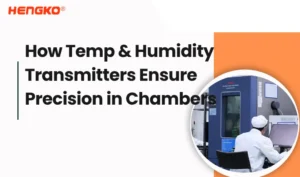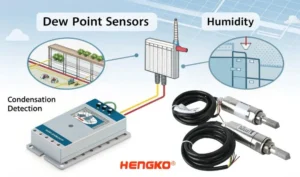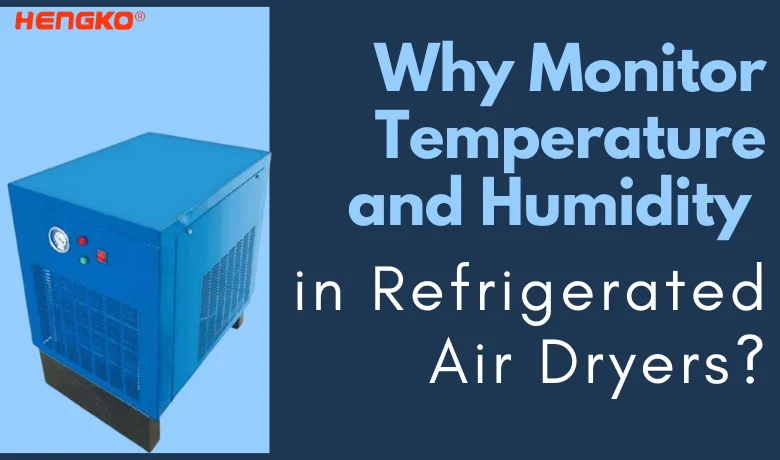Why One Office Zone is Too Humid & How a Humidity Transmitter Fixes It ?
Why One Office Zone is Too Humid & How a Humidity Transmitter Fixes It Persistent
Pålitlig OEM-partner för daggpunktsövervakning i trycklufts-, gas- och torksystem
Hem " Daggpunktsmätare
HENGKO HG970-serien är konstruerad för precision och hållbarhet och erbjuder en tillförlitlig lösning för daggpunktsövervakning i krävande industrimiljöer. Med hög noggrannhet, snabb svarstid och robust konstruktion i rostfritt stål är HG970 idealisk för kontinuerlig onlinemätning i tryckluftssystem, gastorkningslinjer och fuktkänsliga produktionsprocesser. Oavsett om du behöver analog eller digital utgång garanterar HG970-serien stabil prestanda och sömlös integrering i dina styrsystem.
HG970-serien daggpunktsmätare/temperatur och luftfuktighet - urvalsguide
| Modell | Temperaturområde | Mätområden (luftfuktighet / daggpunkt / våtbulb) | Noggrannhet (Temp / RH / Daggpunkt) | Typ av sond | Tillämpning | Funktioner / anteckningar |
| HG970 | -30 ~ 80℃ | Område för luftfuktighet: 0 ~ 100%RH / Daggpunktsintervall: -30 ~ 80°C Td / Våtbulbintervall: 0 ~ 60°C WB | ±0,1℃ / ±1,5%RH / ±3°C Td | Utbytbar sond | Allmän övervakning i HVAC-system, laboratorier och industrilokaler | Standardmodell med lätt utbytbar sond för regelbundet underhåll |
| HG972 | -30 ~ 80℃ | Område för luftfuktighet: 0 ~ 100%RH / Daggpunktsintervall: -30 ~ 80°C Td / Våtbulbintervall: 0 ~ 60°C WB | ±0,1℃ / ±1,5%RH / ±3°C Td | Rund sond | Kompakta system som miljötestkammare, förvaringsskåp eller små kontrollboxar | Platsbesparande rund sond för trånga installationer |
| HG984 | -30 ~ 80℃ | Område för luftfuktighet: 0 ~ 100%RH / Daggpunktsintervall: -30 ~ 80°C Td / Våtbulbintervall: 0 ~ 60°C WB | ±0,1℃ / ±1,5%RH / ±3°C Td | OEM skarp sond | OEM-integration i kompakt utrustning, sensorenheter eller instrumentpaneler | Anpassad skarp probe för inbyggda och OEM-applikationer |
| HG983 | -30 ~ 100℃ | Område för luftfuktighet: 0 ~ 100%RH / Daggpunktsintervall: -30 ~ 80°C Td / Våtbulbintervall: 0 ~ 60°C WB | ±0,1℃ / ±1,5%RH / ±3°C Td | Lång skarp sond | Rörledningar för tryckluft, torkugnar och tankinlopp | Sond med utökad räckvidd, idealisk för instick i kanaler eller djupa portar |
| HG981 | -30 ~ 120℃ | Område för luftfuktighet: 0 ~ 100%RH / Daggpunktsintervall: -30 ~ 80°C Td / Våtbulbintervall: 0 ~ 60°C WB | ±0,1℃ / ±1,5%RH / ±3°C Td | OEM lång sond | Torkrum för litiumbatterier, petrokemiska gasledningar för höga temperaturer | Lång och tålig prob för krävande applikationer med höga temperaturer |
| HG982 | -30 ~ 120℃ | Område för luftfuktighet: 0 ~ 100%RH / Daggpunktsintervall: -30 ~ 80°C Td / Våtbulbintervall: 0 ~ 60°C WB | ±0,1℃ / ±1,5%RH / ±3°C Td | Delad skarp sond | Industriella torkar, uppvärmda luftkammare eller svåråtkomliga miljöer | Delad design för enklare installation och probpositionering |
HG970-serien
Bärbar daggpunktsmätare HG970 - precision i fickan
Den bärbara daggpunktsmätaren är en lättviktig, fältklar enhet som är utformad för snabb,
noggrann mätning av luftfuktighet och daggpunkt i en mängd olika miljöer.
*Kompakt och bärbar - Idealisk för mobil användning vid fältinspektioner och på avlägsna platser
*Hög noggrannhet - Avancerade sensorer säkerställer exakta daggpunktsavläsningar
*Mångsidiga applikationer - Lämplig för HVAC-kontroller, spotmätningar inom industrin och miljöövervakning
*Snabbt svar - Anpassar sig snabbt till förändrade förhållanden för resultat i realtid
*Användarvänligt gränssnitt - Enkla reglage och tydlig display för enkel användning
*Tålig och lättviktig - Byggd för att klara krävande fältförhållanden utan extra volym
*Essentiellt verktyg - Ett måste för yrkesverksamma som behöver tillförlitliga fuktdata när de är på språng
HENGKO är en global ledare inom industriella sensorlösningar, med ett rykte om unik design och utmärkt prestanda. Våra temperatur- och luftfuktighetstransmittrar och sensorer används i ett brett spektrum av industrier, inklusive livsmedel och drycker, läkemedel, tillverkning och miljöövervakning.
Du kan helt anpassa en unik daggpunktssensorprodukt baserat på vår patenterade och egendesignade daggpunktssändarserie.
Du kommer att få mycket lägre och konkurrenskraftigt pris på grund av vår extremt kostnadseffektiva kontroll.
Du kommer alltid att möta de ständigt föränderliga marknadsbehoven med våra ständigt uppgraderade produkter.
Du kommer att få starkt marknadsföringsstöd för att hjälpa dig att sälja produkter framgångsrikt, materialstöd inkluderar: högupplösta produktbilder, coola 3d-effektvideor och mycket mer.










Daggpunktssensor för övervakning av tryckluftssystem: Säkerställ optimal fuktkontroll och luftkvalitet för din luftkompressormaskin
HENGKO är en pålitlig tillverkare av högpresterande daggpunktstransmittrar, temperatur- och luftfuktighetstransmittrar samt portabla daggpunktsmätare.
Vi är specialiserade på att leverera ett omfattande utbud av övervakningslösningar som är skräddarsydda för att uppfylla de exakta behoven i industri- och miljöapplikationer.
Våra produkter är konstruerade för noggrannhet, hållbarhet och långsiktig stabilitet och säkerställer tillförlitlig prestanda under krävande förhållanden. Oavsett om du letar efter en exakt daggpunktssensor eller en robust fukttransmitter, erbjuder HENGKO både teknik och expertis för att stödja ditt projekt.
👉 Kontakta oss idag för att utforska skräddarsydda lösningar som passar dina övervakningsutmaningar.






A Daggpunktsmätare är ett precisionsinstrument som används för att mäta daggpunktstemperatur-temperaturen vid vilken fukt i luft eller gas börjar kondensera till flytande vatten. Det är en nyckelparameter för att förstå luftfuktighetsnivåer och fuktinnehåll i olika industri- och miljötillämpningar.
Åtgärder daggpunktstemperatur i °C eller °F
Indikerar luftfuktighet mättnad i luft eller gaser
Hjälper till att upptäcka fuktförorening i tryckluft, gaser eller kontrollerade miljöer
System för komprimerad luft (förhindrar ansamling av vatten)
Torkningsprocesser för gas (t.ex. kväve, argon, väte)
HVAC-system (säkerställa kontroll av inomhusklimatet)
Torra rum för litiumbatterier (fuktkänsliga miljöer)
Läkemedels- och livsmedelsproduktion (fuktkänslig förvaring)
| Typ | Beskrivning |
|---|---|
| Bärbar daggpunktsmätare | Handhållen, används för stickprovskontroller och fältdiagnostik |
| Online daggpunktsmätare | Fast installation, skickar realtidsdata till styrsystem (t.ex. 4-20 mA, RS485) |
| Hygrometer av spegeltyp | Laboratoriekvalitet, ultraexakt men kostsamt |
Förhindrar korrosion, kondens och produktdefekter
Säkerställer efterlevnad av branschstandarder (ISO, GMP etc.)
Förbättrar energieffektiviteten och utrustningens livslängd
Kontroll av daggpunkten med HG970-serien bärbar daggpunktsmätare från HENGKO är en exakt, effektiv och tillförlitlig process som är utformad för både industriella fältinspektioner och mätningar av laboratoriekvalitet. HG970-serien erbjuder olika sondkonfigurationer för att passa ett brett spektrum av applikationer, från allmänna HVAC-system till torkmiljöer med höga temperaturer. Nedan följer en steg-för-steg-guide och en teknisk översikt över hur daggpunktsmätningen utförs med detta instrument.
HG970-serien innehåller flera olika probtyper (t.ex. utbytbara, vassa, långa, delade) och temperaturområden (-30°C till 120°C), så att användarna kan välja den lämpligaste modellen utifrån sin mätmiljö. Ett exempel:
HG970 / HG972: Idealisk för allmänna industri- och HVAC-applikationer.
HG981 / HG982: Rekommenderas för miljöer med höga temperaturer (80-120°C), t.ex. torkrum för litiumbatterier och gasledningar.
Kontrollera att enheten är strömförsörjd (via extern strömförsörjning eller fältinställning).
Anslut proben ordentligt till testpunkten, rörporten eller miljökammaren.
För korrekta resultat, undvik att utsätta sensorn för plötsliga fuktstötar eller föroreningar som olja eller damm innan avläsningen stabiliseras.
När HG970:s inbyggda sensormodul är ansluten tar den kontinuerligt prover på luften eller gasen och mäter parametrar som t.ex:
Daggpunktstemperatur (°C eller °F)
Relativ luftfuktighet (%RH)
Omgivande temperatur (°C/°F)
Dessa värden beräknas med hjälp av HENGKO:s avancerade polymera kapacitiva eller keramiska sensorteknik, vilket ger snabb svarstid och hög noggrannhet även i dynamiska miljöer eller miljöer med hög luftfuktighet.
Om modellen har en LCD-skärm eller ett digitalt gränssnitt (tillval) är avläsningarna visas i realtid. För modeller utan display överförs utdata via:
Analog signal (4-20 mA / 0-10 V)
Digital kommunikation (RS485 / Modbus-RTU)
Dessa utgångar kan loggas via en datalogger, PLC eller programvara för fjärrövervakning.

Daggpunktstemperaturen talar om för dig exakt punkt där kondens skulle uppstå under rådande tryck- och luftfuktighetsförhållanden. Lägre daggpunkter indikerar torrare luft, vilket är avgörande för:
Förhindra korrosions- eller fuktskador i pneumatiska verktyg eller tryckluftssystem
Upprätthålla strikt kontroll av luftfuktigheten i renrum, torra rum eller gastorkningsprocesser
Till exempel:
Daggpunkt < -40°C: Lämplig för gassystem med hög renhet och litiumbatterimiljöer.
Daggpunkt 0 ~ 10°C: Typisk för HVAC, livsmedelsförvaring och allmänna industriella tillämpningar.
För att upprätthålla tillförlitlig prestanda:
Kalibrera enheten med jämna mellanrum (vanligtvis en gång var 6-12:e månad) mot en spårbar standard.
Rengör eller byt ut givarsonden efter behov, särskilt om den används i tuffa eller dammiga miljöer.
Förvara enheten på en torr och ren plats när den inte används.
✅ Wide temperature and humidity range
✅ Interchangeable probe options for different environments
✅ Compact and robust construction for field use
✅ High accuracy and fast response time
✅ Optional OEM customization for unique industrial requirements
Contact HENGKO’s technical team at ka@hengko.com or visit www.hengkometer.com to get personalized advice based on your industry, installation method, and measurement conditions.
Den HG970 series dew point transmitters from HENGKO are designed for industrial-grade dew point monitoring with high precision and stability. The normal dew point measurement range of the HG970 series is typically:
-60°C to +60°C Td (typical)
(Custom ranges available upon request)
| Parameter | Details |
|---|---|
| Typical Range | -60°C ~ +60°C dew point (Td) |
| Område för luftfuktighet | 0%RH to 100%RH |
| Temperaturområde | -30°C to +120°C (varies by model, e.g., HG970 to HG982) |
| Sensortyp | Polymer capacitive or ceramic sensor (high accuracy, fast response) |
| Output Signal | 4–20mA, 0–5V, 0–10V, RS485 / Modbus-RTU |
| Noggrannhet | ±2°C Td typical (customizable based on sensor class) |
-60°C to -20°C Td: Ideal for compressed air drying systems, lithium battery dry rooms, or gas drying
-20°C to +20°C Td: Common in HVAC-system, pharmaceutical environments, och storage facilities
+20°C to +60°C Td: Suitable for high-moisture process areas, or climate chambers
If you need a customized dew point range, HENGKO can tailor the sensor configuration based on:
Target environment (dry gas, ambient air, high temp zone)
Accuracy requirement
Signal output preferences
📩 Contact: ka@hengko.com to request a custom specification or get technical support.
This is Great question!
Understanding the difference between daggpunkt och luftfuktighet is key to accurately evaluating air moisture content
—especially in industrial, HVAC, and environmental monitoring applications.
| Aspect | Daggpunkt | Humidity (Relative Humidity, %RH) |
|---|---|---|
| Definition | Den temperatur at which air becomes fully saturated and water vapor condenses into liquid | Den percentage of water vapor in the air compared to the maximum it can hold at a given temperature |
| Unit | °C or °F (Temperature) | %RH (Percentage) |
| Absolute/Relative? | Absolute measure of moisture content | Relative measure (depends on air temperature) |
| Temperature Dependent? | No – dew point is not affected by ambient temperature | Yes – higher temperatures can hold more moisture, affecting %RH |
| What it tells you | How dry or moist the air actually is | How close the air is to saturation at a given temperature |
| Used for | Precise control in drying, gas purity, industrial process monitoring | General comfort, climate control, environmental monitoring |
| Example | Dew point of -40°C = extremely dry air (used in lithium battery rooms) | 60%RH at 25°C = moderately humid air |
Daggpunkt = “How much water is really in the air?”
Relative Humidity = “How full is the air’s moisture tank at this temperature?”
| Ambient Temp | Daggpunkt | Relative Humidity |
|---|---|---|
| 25°C | 10°C | ~45%RH |
| 25°C | 20°C | ~75%RH |
| 25°C | 24°C | ~95%RH |
Användning Daggpunkt for:
Compressed air drying systems
Inert gas monitoring (N₂, Ar, H₂)
Torra rum för litiumbatterier
Användning %RH for:
Indoor air quality
HVAC system control
Agricultural storage
Even though the temperature is the same, the dew point increases with more water vapor in the air, which raises the relative humidity.
Both devices are used to measure the dew point temperature, a critical parameter in determining moisture levels in air or gas. However, they differ significantly in design, application, och integration method.
| Aspect | Beskrivning |
|---|---|
| Measurement Function | Both measure daggpunktstemperatur accurately to detect moisture levels |
| Sensor Technology | Typically use similar capacitive or ceramic humidity sensors |
| Target Media | Both used with air, compressed gases, dry gases, etc. |
| Tillämpningar | Found in industrial, HVAC, environmental monitoring, och gas drying |
| Feature / Aspect | Daggpunktsmätare | Daggpunktstransmitter |
|---|---|---|
| Form Factor | Portable or handheld | Fixed-installation / inline sensor |
| Display | Built-in LCD or digital display | Usually no display (or optional), outputs data to external systems |
| Power Source | Battery-powered or rechargeable | Externally powered (e.g., 24V DC) |
| Output Signal | Internal data logging, USB export (optional) | Analog (4-20 mA, 0-10V) or Digital (RS485/Modbus-RTU) |
| Use Case | On-site spot checks, mobile inspections | Continuous online monitoring & automation systems |
| User Type | Technicians, maintenance staff | Engineers, system integrators, automation specialists |
| Installation | Handheld use or temporary probe connection | Installed permanently in pipelines, dryers, tanks, etc. |
| Prisintervall | Generally higher due to display and portability features | More cost-effective for long-term embedded use |
| Typical Examples | Vaisala DM70, Michell MDM300, HG970 series | HENGKO HG970, Vaisala DMT143, E+E EE371 |
| Scenario | Recommended Device |
|---|---|
| Field diagnostics and mobile inspections | Daggpunktsmätare |
| Continuous monitoring in a compressed air line | Daggpunktstransmitter |
| Temporary measurements in different locations | Daggpunktsmätare |
| Integration into control/SCADA systems | Daggpunktstransmitter |
Dew Point Meters are portable tools designed for manual measurements, great for spot-checking and troubleshooting.
Dew Point Transmitters are installed devices built for long-term, real-time monitoring och system automation.
4-20mA-utgången är ett populärt val för daggpunktsgivare eftersom det är en industriell standardutgång som är kompatibel med ett brett utbud av styrsystem. Det är också en mycket tillförlitlig och ljudtålig utgång, vilket gör den väl lämpad för användning i tuffa industrimiljöer.
Här är några av fördelarna med att använda en 4-20mA-utgång för daggpunktsgivare:
Kompatibilitet: Utgången på 4-20 mA är kompatibel med ett stort antal styrsystem, inklusive PLC, DCS och SCADA-system. Detta gör det enkelt att integrera daggpunktsgivare i befintliga styrsystem.
Tillförlitlighet: 4-20mA-utgången är en mycket tillförlitlig utgång som inte är känslig för brusstörningar. Detta är viktigt för daggpunktsgivare, som ofta används i tuffa industriella miljöer.
Noggrannhet: Utgången 4-20 mA kan ge exakta mätningar av daggpunkten. Detta är viktigt för applikationer där exakt kontroll av daggpunkten krävs.
Range: Utgången på 4-20 mA kan täcka ett brett intervall av daggpunktsvärden. Detta gör den lämplig för en mängd olika applikationer.
Kostnad: 4-20mA-utgången är en relativt billig utgång att implementera. Detta gör den till ett kostnadseffektivt alternativ för daggpunktsgivare.
Förutom de fördelar som anges ovan är 4-20mA-utgången också en mycket mångsidig utgång. Den kan användas för att överföra en mängd andra parametrar, t.ex. temperatur, tryck och flödeshastighet. Detta gör den till en värdefull utgång för ett brett spektrum av industriella applikationer.
Här följer några exempel på applikationer där daggpunktsgivare med 4-20mA-utgångar ofta används:
System för komprimerad luft: Daggpunktsgivare används i tryckluftssystem för att övervaka och kontrollera luftens fuktinnehåll. Detta är viktigt för att förhindra korrosion och andra skador på utrustningen.
HVAC-system: Daggpunktsgivare används i HVAC-system för att kontrollera luftfuktigheten i byggnader. Detta är viktigt för människors komfort och hälsa.
Industriella torkningsprocesser: Daggpunktsgivare används i industriella torkningsprocesser för att övervaka och kontrollera fukthalten i den produkt som torkas. Detta är viktigt för att säkerställa produktens kvalitet.
Förädling av livsmedel och drycker: Daggpunktssensorer används inom livsmedels- och dryckesindustrin för att kontrollera fukthalten i den produkt som bearbetas. Detta är viktigt för att säkerställa produktens säkerhet och kvalitet.
Miljöövervakning: Daggpunktssensorer används i miljöövervakningsstationer för att spåra förändringar i fukthalten i atmosfären. Denna information kan användas för att förutse väderförhållanden och för att identifiera potentiella miljöproblem.
Som du kan se är daggpunktsgivare med 4-20mA-utgångar ett värdefullt verktyg för ett brett spektrum av industriella applikationer. De är tillförlitliga, exakta och mångsidiga och kan enkelt integreras i befintliga styrsystem.
Priset på daggpunktstransmittrar kan variera beroende på tillverkare, funktioner och transmitterns noggrannhet. I allmänhet kostar daggpunktstransmittrar med högre noggrannhet och fler funktioner mer än daggpunktstransmittrar med lägre noggrannhet och färre funktioner.
Baserat på min forskning skulle jag säga att priset på daggpunktstransmittrar i allmänhet är rimligt. Kostnaden för de komponenter och det arbete som krävs för att tillverka daggpunktstransmittrar är hög, och de företag som tillverkar daggpunktstransmittrar måste få tillbaka dessa kostnader för att kunna fortsätta sin verksamhet. Dessutom används daggpunktstransmittrar i en mängd olika kritiska applikationer, så det är viktigt att de är tillförlitliga och exakta. Det höga priset på daggpunktstransmittrar återspeglar det faktum att de är högkvalitativa instrument som man kan lita på ger exakta mätningar.
Här är några faktorer som kan påverka priset på en daggpunktstransmitter:
Här är en tabell över prisintervallet för daggpunktstransmittrar på marknaden:
| Typ | Prisintervall |
|---|---|
| Kyld spegel | $2,000 – $10,000 |
| Polymer | $500 – $2,000 |
| Metalloxid | $500 – $1,500 |
Som du kan se kan prisintervallet för daggpunktstransmittrar variera beroende på typen av transmitter. Daggpunktstransmittrar med kyld spegel är den dyraste typen av transmitter, men de är också de mest exakta. Polymer- och metalloxiddaggpunktstransmittrar är billigare, men de är också mindre exakta.
Priset på daggpunktstransmittrar kan också variera beroende på transmitterns funktioner. Daggpunktstransmittrar med dataloggning, larmbörvärden och fjärråtkomstfunktioner kostar t.ex. normalt mer än daggpunktstransmittrar med färre funktioner.
Om du letar efter en daggpunktssändare av hög kvalitet rekommenderar jag att du köper en från ett välkänt varumärke som har ett gott rykte när det gäller kvalitet och tillförlitlighet. Du bör också fundera över vilka funktioner som är viktiga för dig och vilken noggrannhet du behöver. Om du inte är säker på vilken daggpunktssändare som är rätt för dig rekommenderar jag att du rådgör med en fackman som kan hjälpa dig att fatta ett välgrundat beslut.
some questions about Dew Point Meter you like to know
A Daggpunktsmätare är ett precisionsinstrument som används för att mäta daggpunktstemperatur — the temperature at which air or gas becomes saturated with moisture and water vapor begins to condense into liquid.
It works by sensing the relative humidity and temperature of the environment or gas stream, then calculating the dew point based on the current saturation level. Most modern dew point meters use capacitive or ceramic sensors for real-time measurements, offering high accuracy and stability across a wide range of industrial applications.
Dew point measurement is critical for moisture control, especially in applications where excess humidity can lead to equipment failure, corrosion, product spoilage, or safety risks.
Industries such as tryckluftssystem, pharmaceuticals, lithium battery manufacturing, semiconductors, och food packaging depend on dew point monitoring to ensure dry environments and gas purity. In compressed air lines, for example, a low dew point prevents water buildup, which could otherwise damage tools and contaminate end products.
Daggpunkt is the absolute temperature at which air becomes saturated and water vapor condenses, while humidity (usually relative humidity) is a percentage expressing how much moisture the air currently holds compared to its maximum capacity at a given temperature.
In simple terms:
Daggpunkt tells you how much moisture is actually in the air (in °C or °F).
Relative humidity tells you how close the air is to saturation (in %RH).
Dew point is more accurate for industrial applications, especially when monitoring drying processes or compressed air systems.
In industrial compressed air systems, the target dew point depends on the drying method och application sensitivity:
| Tillämpning | Recommended Dew Point |
|---|---|
| General industrial use | -20°C to -40°C |
| Instrumentation or electronics | -40°C to -70°C |
| Medical/Pharma cleanrooms | ≤ -40°C |
| Standard shop air (non-critical) | 0°C to -10°C |
A lower dew point means drier air, which is essential for high-performance or sensitive operations. The dew point meter helps monitor this and ensure system compliance.
Yes. Most dew point meters — including advanced portable models — can be used to measure dew point in a variety of non-corrosive gases, such as nitrogen (N₂), argon (Ar), carbon dioxide (CO₂), och compressed natural gas (CNG).
However, it is important to verify:
Sensor compatibility with the target gas
Pressure rating of the probe or housing
Flow regulation to avoid sensor contamination
Some models, like the HENGKO HG970 series, offer custom probe materials and protective filters for specialized gas monitoring applications.
For most industrial and professional uses, dew point meters should be calibrated every 6 to 12 months, depending on usage frequency, environmental conditions, and accuracy requirements.
Regular calibration:
Ensures data reliability
Maintains regulatory compliance (e.g., ISO, GMP)
Extends the lifespan of the sensor
HENGKO and other manufacturers often offer traceable calibration services and replacement sensors for field units.
Typical high-quality portable dew point meters can measure within a range of:
-80°C to +60°C (or -112°F to +140°F)
For example, the HG970 series by HENGKO is commonly used to monitor dew point ranges from -60°C to +60°C, making it suitable for most industrial air and gas drying applications. Some lab-grade mirror hygrometers may extend lower, but portable models balance range with portability and cost-effectiveness.
Using a portable dew point meter is straightforward:
Power on the device (battery or external power).
Connect the probe to the sample point or open environment.
Allow stabilization time (usually 30 seconds to a few minutes).
Observe the real-time dew point reading on the display or via signal output.
Log or export data if required (some models offer USB or Bluetooth).
Always make sure the sensor is clean, calibrated, and not exposed to oil, dust, or corrosive chemicals.
A Daggpunktsmätare is portable and often used for spot-checking or mobile diagnostics.
A Daggpunktstransmitter is a fixed, inline sensor installed for continuous monitoring in automated systems.
Dew point meters typically include a display and internal battery, while transmitters are integrated with PLCs or data loggers via analog (4-20mA) or digital (RS485/Modbus) output.
Yes — if it’s rated for industrial or field use. Look for:
IP-rated housing for dust and moisture protection
Stainless steel probe construction
Temperature range compatibility (e.g., -30°C to +120°C)
Shock-resistant casing
Models like the HENGKO HG970 series are designed for demanding conditions, including outdoor gas lines, drying towers, or factory production lines.
Kontakta HENGKO idag om du har frågor om temperatur- och fuktgivare, sändare och lösningar
Why One Office Zone is Too Humid & How a Humidity Transmitter Fixes It Persistent

Introduction Compressed air is often referred to as the “fourth utility” in modern industry, alongside

1. Introduction The semiconductor industry operates under some of the most stringent environmental conditions of

Introduction In the world of environmental simulation and reliability testing, constant temperature and humidity chambers

Are you grappling with how dew point sensors impact industrial efficiency? These sensors play a
Why One Office Zone is Too Humid & How a Humidity Transmitter Fixes It Persistent humidity in one office zone can disrupt comfort, increase mold
Why One Office Zone is Too Humid & How a

Introduction Compressed air is often referred to as the “fourth

1. Introduction The semiconductor industry operates under some of the
WhatsApp oss